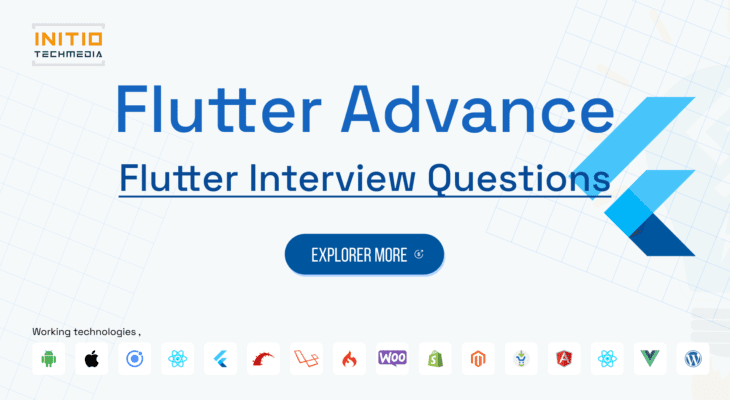Leading Mobile & web Development company which is providing Ready to publish apps & on demands application in Global Bussiness.
- 908, B Square 2, Ambli Rd, near Hotel Double tree Hilton, Vikram NagarAhmedabad-380054, Gujarat, India
- (+91) 8758432204Give us a call
- contact@initiotechmedia.com24/7 online support

20 Common Flutter Interview Questions and Answers: Your Ultimate Guide
- payal patel
- March 22, 2023
- 0
Flutter is a popular mobile app development framework that is widely used for building high-performance, cross-platform mobile applications. It is an open-source framework developed by Google, and it uses the Dart programming language. If you’re preparing for a Flutter interview, here are 20 commonly asked questions and their answers to help you out:
1.What is Flutter and how is it different from other mobile app development frameworks?
ans : Flutter is a mobile app development framework that allows you to create native-like mobile apps for Android and iOS platforms using a single codebase. It is different from other frameworks because it uses a reactive programming model that allows for fast development and easy maintenance.
2.What programming language is used in Flutter development?
Flutter uses the Dart programming language, which is also developed by Google. Dart is an object-oriented language that is easy to learn and is optimized for client-side development.
3.How does Flutter achieve high performance and fast development?
Flutter achieves high performance by using a high-performance rendering engine called Skia. It also uses a Just-In-Time (JIT) compiler during development, which allows for faster development cycles.
4.What is a widget in Flutter?
In Flutter, a widget is a building block for the user interface of your app. Widgets can be combined to create complex user interfaces, and they can represent anything from a button to an entire screen.
5.How does state management work in Flutter?
State management in Flutter refers to the process of managing the state of your app’s user interface. Flutter provides several options for state management, including setState(), Provider, and Bloc.
6.What are the different types of widgets in Flutter?
There are two types of widgets in Flutter: stateless widgets and stateful widgets. Stateless widgets are immutable and don’t have any mutable state, while stateful widgets have mutable state that can change over time.
7.How can you create custom widgets in Flutter?
You can create custom widgets in Flutter by extending either the StatelessWidget or StatefulWidget class and defining the behavior of the widget in the build method.
8.What is the difference between Hot Reload and Hot Restart in Flutter? Hot Reload allows you to make changes to your code and see the changes immediately without losing the current state of your app. Hot Restart, on the other hand, completely restarts your app and resets its state.
9.What is the pubspec.yaml file in Flutter?
The pubspec.yaml file is a configuration file in Flutter that is used to specify dependencies, assets, and other metadata for your app.
10.How can you add a new dependency in Flutter?
You can add a new dependency in Flutter by adding the dependency to the pubspec.yaml file and running the command “flutter packages get” to install the dependency.
11.What is the difference between Future and Stream in Flutter?
Future represents a value that may not be available yet, while Stream represents a sequence of values that are delivered over time.
12.What is the difference between Navigator.push() and Navigator.pushReplacement() in Flutter?
Navigator.push() adds a new route to the navigation stack, while Navigator.pushReplacement() replaces the current route with a new route.
13.What is a MaterialApp widget in Flutter?
A MaterialApp widget is a top-level widget in Flutter that provides several pre-built widgets for building the user interface of your app, including a navigation drawer, app bar, and more.
14.What is a Scaffold widget in Flutter?
A Scaffold widget is a basic visual structure for a Material Design app. It provides a framework for implementing the basic material design layout of your app, including a navigation drawer, app bar, and more.
15.What is a FutureBuilder widget in Flutter?
A FutureBuilder widget in Flutter is a widget that allows you to build a widget tree based on the state of a Future. It allows you to asynchronously
16.What is a GlobalKey in Flutter?
A GlobalKey is an identifier that is used to uniquely identify a widget in the widget tree. It is often used for accessing a specific widget from another part of the widget tree.
17.What is the difference between StatefulWidget and StatelessWidget in Flutter?
StatefulWidget is a widget that has mutable state, while StatelessWidget is a widget that is immutable and does not have any mutable state.
18.What is the purpose of the main() function in Flutter?
The main() function in Flutter is the entry point of the app, and it is responsible for creating and running the app.
19.What is the purpose of the initState() function in Flutter?
The initState() function in Flutter is a method that is called when a stateful widget is inserted into the widget tree for the first time. It is used to initialize the state of the widget.
20.What is the purpose of the dispose() function in Flutter?
The dispose() function in Flutter is a method that is called when a stateful widget is removed from the widget tree. It is used to clean up any resources that the widget has allocated.
WhatsApp us

